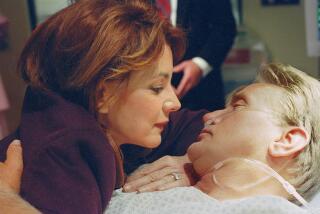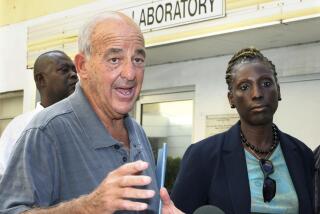Events forever shrouded in mystery
- Share via
The striking thing about Dealey Plaza in Dallas, where President John F. Kennedy was killed on Nov. 22, 1963, is that it is not very striking at all -- no grand civic space, just a modest sloping triangular patch of green at the edge of downtown where three roads converge and run under a railroad bridge. (That it’s a National Historic Landmark District has kept it old and small.) It seems remarkably ordinary to bear the weight of all the history that changed there.
The first good thing to say about Robert Stone’s “Oswald’s Ghost,” a new documentary on the assassination and its psychic fallout, is how well it conveys the feel of that space and what fills it. The rest of the film does much the same, catching the way that the extraordinary sits within the everyday, and how unpredictable, impulsive acts can retrospectively acquire the force of immutable destiny.
Premiering tonight as part of the PBS “American Experience,” it’s a meditation on the events as much as it is a recitation of them. More arty than newsy, it has not come to blow your mind with startling new revelations or to support or debunk any particular conspiracy theory -- except for the hard-not-to-debunk, contorted fancies of Jim Garrison, the man Oliver Stone made “JFK” about. (There is footage newly or rarely seen, it has been advertised, but I couldn’t tell you what it is.) The film’s real subject is what it means not to know and the suspicions and contentions that grow from that. It’s the sore that America keeps scratching. It’s the black screen at the end of “The Sopranos,” history’s great undropped shoe.
Because Oswald never spoke, other than to deny everything and declare himself “a patsy,” he will remain permanently unfinished, no matter how exhaustive and exhausting the evidence one way or another. It’s a subject defined by questions -- all the questions that have been asked about it, and the questions that have been asked about the questions. One need only dip a toe into the sea of theories surrounding Kennedy’s death, and Oswald’s, to see that that way madness lies.
So it was the Cubans, or the Cuban exiles, or the CIA, the KGB, the Mafia, the Red Chinese, the North Vietnamese, Lyndon B. Johnson, or some unholy combination thereof who were behind it all, each new conspiracy theory calling into question those before it. Such theories share “a certain plausibility and a depressing lack of proof,” says the late Norman Mailer, a semi-reformed conspiracy theorist. But although the structure of his film tends to draw you toward a lone-gunman conclusion, Stone (director also of “Guerrilla: The Taking of Patty Hearst”) also gives time to the doubters, including attorney Mark Lane, whose “Rush to Judgment” was the early main text of conspiracy thought. Of course, they all doubt differently.
What is less obscure is the aftermath, the dispiriting effect on the country, the thirst for answers and the widespread distrust of the official story. “People are comforted by the idea . . . that human affairs are not the product of random events,” says historian Robert Dallek -- the search for meaning in these events, the desire to protect them from meaninglessness, spawned hordes of amateur and professional detectives, with no end in sight. (There is that funny term, “assassination buff.”) It also, Stone’s film says, changed how a generation viewed the world, creating a distrust of authority that led to riots in the streets of Chicago and found confirmation in the secret machinations of the Nixon administration. “Sometimes,” says Dan Rather, “conspiracy theories turn out to be true.”
Whatever lies beneath the surface of the events, I’ve never seen them portrayed with more immediacy than they are here. (Some of the TV images are shockingly crisp.) Stone artfully orchestrates archival footage -- not just the Zapruder film but much else that was shot that day and after -- to give a sort of experiential understanding of the moment. It puts you there, in the plaza, in such a way you can almost feel that things might still happen differently.
And then they don’t.
--
--
‘American Experience: Oswald’s Ghost’
Where: KCET
When: 9 tonight
Rating: TV-PG (may be unsuitable for young children)
More to Read
Only good movies
Get the Indie Focus newsletter, Mark Olsen's weekly guide to the world of cinema.
You may occasionally receive promotional content from the Los Angeles Times.








